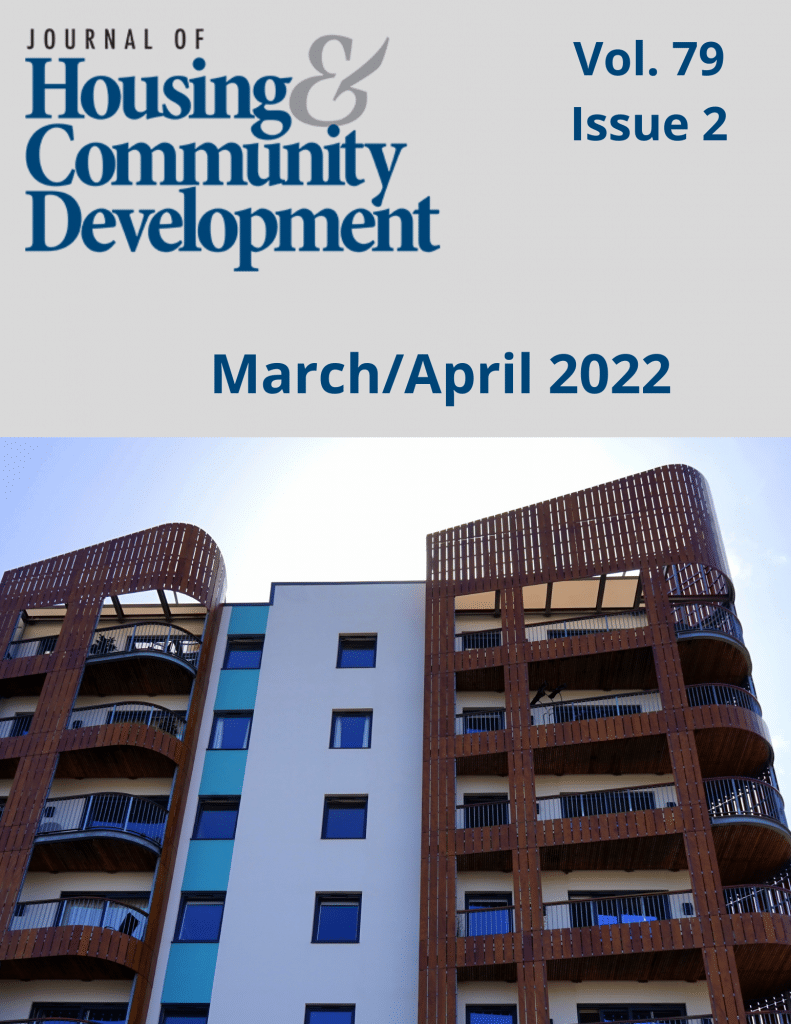Build Back Better: A Priority to Preserve and Transform Affordable Housing in the US

Today, there are three core programs that compose the U.S affordable housing framework and support our nation’s mixed free market economy.
First, the public housing production program began with passage of the U.S Housing Act of 1937 under President FDR. Its first developments were built in Atlanta, Techwood and University Homes.
Second, the Section 8 program that provides tenant and project-based subsidies enabling families or individuals to purchase single family or multifamily units in the rental market began in 1974 during the Nixon Administration.
Third, an infusion of private capital increased affordable-priced multifamily production through the Low-Income Housing Tax Credit (LIHTC) program under the 1986 tax code. Each of these programs are necessary toward the goal to produce an adequate supply of affordable housing nationally and provide subsidies to ensure available multifamily and single-family rental properties are affordable in the private rental market. Currently, each are in need of an infusion of funding as proposed in the Build Back Better (BBB) Act passed by the House.
If the Senate does not come to agreement, the shortage in affordable supply will not be reduced as private and public sector production has not made headway with reducing the national shortage. Demand for affordable rental units continues to outweigh supply.
By the press deadline, enactment of BBB is not expected. This article presents a factual case underscoring the need for preservation and production to reduce the affordable housing supply shortfall, but this spending bill is stalled in the Senate for political reasons due to concerns about inflation, the $30 trillion debt of the Federal Government and shifting priorities abroad toward military support for Ukraine against the unprovoked invasion by Russia. Despite the lack of unanimity in the Democratic caucus nor bi-partisan support for modernization and production spending that would enable our industry to make headway to reduce the national supply shortfall, we must remain resolute in our advocacy efforts. We must pivot toward the mid-term elections and seek bi-partisan support for obtaining a plural majority from both chambers of Congress to preserve and increase our Nation’s affordable supply for working families and those most in need.
HUD’s biennial worst case needs report for 2021 indicated 7.77 million renter households experienced worst-case needs, meaning they were homeless or over-burdened and paying more than 50% of their monthly income for housing costs.
The 2021 report continues to demonstrate housing production does not keep pace with producing an adequate supply for our nation’s working poor and most vulnerable with modest incomes. This is exacerbated in high-cost urban and suburban areas, but is similar in small town rural communities.
Regulatory Reform Stop and Starts to Transform the Public Housing and Section 8 Safety Net Programs that Serve the Working Poor and Most Needy
In the early 1990s the Federal Government was about to give up on public housing.
In the mid-nineties, during the Clinton Administration when Henry Cisneros was HUD Secretary, a national debate ensued on the cost -effectiveness of public housing versus vouchers, while in practice historically and up to the present both are necessary to ensure an adequate supply is maintained in urban, suburban, and rural markets across the nation.
Since the early 1990s, the affordable industry has gone through a series of bell-curve stop and starts in terms of reform. A paradigm shift has been necessary to right-size the regulatory framework and align the public housing and production programs and repositioning of the inventory with private, conventional multi-family practices. Recall, the inventory removal actions including repeal of one-for-one replacement, the Faircloth limit, mandatory and voluntary conversion, the easing of demolition/ disposition actions and how the Section 8 voucher and certification programs were streamlined and merged into one Housing Choice Voucher program.
Prior to joining HUD, in an interview, I recall Rod Solomon, a former Deputy Assistant Secretary at HUD who had been involved with public housing reform deliberations with the Congress, asking me “what did I think of the deregulation associated with QHWRA.” I remarked “it was beneficial, but more re-regulation than de-regulation.” as it preserved the two premiere safety net programs, public housing and Section 8.
By 1998 the Congress struggled to reach a compromise and enact QHWRA which represented reform and re-regulation of these safety net programs.
Demolition of Over 240,000 Public Housing Units
The reform movement continued in the early 2000s, as the debate continued, and adequate funding was not appropriated for public housing modernization or to fully replace the stock being demolished. Congress preferred Section 8 funding increases over adequate public housing modernization. HOPE VI and later Choice Neighborhood funds have not kept pace to curtail the repair backlog and loss of supply stemming from demolition of distressed developments.
Shortfall in Capital Funding as RAD Recapitalizes Properties as PHAs Cobble Together Private Financing
This culminated with the conversion of public housing subsidies to Section 8 assistance under the Rental Assistance Demonstration (RAD), but again without the necessary funding that PHAs must cobble together to renovate properties with private development partners.
Stop and Starts from One Administration to the Next
Over the last 30 years, there have been pendulum swings and fluctuations involving regulatory reform and funding efforts between Democratic and Republican Administrations and the Congress.
Appropriations levels for Federal Section 8 subsidies have risen and fallen, while public housing modernization, replacement of demolished distressed buildings and production has lagged behind demand. Most development deals take two to four years from conception to groundbreaking if adequate public and private construction funding are available.
Reduction in Affordable Supply Nation-Wide and in High-Cost Urban Cities
This shortfall in producing supply has been constant since 1992. In 1992, the Commission on Severely Distressed Housing identified the need to demolish 100,000 distressed large-scale public housing developments in urban cities and nation-wide. However, this resulted in the demolition of over 240,000 units by 2004. The inventory shrunk from 1.3 to less l than 1.1 million.
An Example of Progress in Atlanta
In October 2021, Atlanta Housing held a groundbreaking for 97 senior multifamily units at Herndon Square. It is the second phase of replacement construction at the former Herndon Homes community. In December 2021, Atlanta held a second financial closing on a $33 million 116-uit multi-family building financed with bank loans by Bank of America and 4% tax credits with a private development partner in what has become a trendy in-town neighborhood just east of the State Capitol. The funding called for in BBB will make projects like these possible.
Projects like these are not possible without Congressional appropriations targeted for public housing. As PHAs across the nation, compete for oversubscribed LIHTCs, we need the volume cap increase and increased public housing appropriations. The $65 billion for modernization, and new construction in the Build Back Better (BBB) legislation that is stalled in the Senate is needed to continue these successful local production and replacement efforts.
The National Shortage in Affordable Supply Begins in Local Communities
Today, in Atlanta we rebuild amenity-rich residential communities anyone would like to live in while preserving the safety net affordable mission for the most vulnerable seniors, disabled and homeless.
In Atlanta, we are implementing a dual strategy to build and increase affordable supply in low-poverty areas that are economically integrated and in neighborhoods in need of revitalization that have become attractive for high-income earners to move into and are experiencing gentrification and loss of the limited affordable supply.
Currently, Atlanta Housing is actively planning 10 master-planned residential communities for a total of $ 1.1 billion. In tandem, the modernization of 7 public housing high rises undergoing conversion to Section 8-assistance under HUD’s Rental Assistance Demonstration (RAD) program are $70.86 million and are expected to increase over time.
Lessons Learned and the Origins of Innovation
In the 1990s, Nelson Diaz, former judge and HUD General Counsel during the Clinton Administration, issued a landmark memo authorizing private ownership and development of public housing using private and public funding under a mixed-finance framework. This opinion enabled PHAs to begin using tax credits and private loans to modernize distressed developments. As Jared Brey writes, “the opinion helped inaugurate a new model for affordable-housing development that mixed public and private funding sources with federal low-income housing tax credits.”
In 1996, the Congress created the Moving -to-Work Demonstration program permitting HUD and the Congress to design innovative policies and ways to more effectively administer these two hard unit supply and demand subsidy programs that operate in a regulated market, while PHAs in varying degrees are permitted to consider local market conditions.
Across the nation, the majority of affordable housing production has continued by local housing and community development agencies and non-profit and private developers using the LIHTC program in tandem with the HOME program.
Local housing agency preservation and production and mixed-finance development with private developers has been beneficial toward increasing PHA modernization and production capacity, but this has not been sufficient to reverse the lost supply due to public demolitions.
BBB has promise as it calls for $53 billion in funding for “priority capital investments” that HUD could provide to PHAs in competitive awards or through the capital fund formula for modernization, new construction or replacement of public or assisted housing. It is sorely needed to replace lost affordable supply in areas with very tight markets and high costs where the supply built by private developers is insufficient.
As our industry knows, annual capital fund appropriations are less than the $2.2 billion in capital repair needs that accrue annually, and the replacement housing (Demolition Disposition Transition) funds allocated through the Capital Fund formula that disburse less than 1/2 of the funding required to rebuild demolished public housing units. Again, BBB, provides for $10 billion in increases in the Capital Fund to offset these historic shortfalls.
During the early 2000’s while the Congress and HUD debated extension or sunset of the HOPE VI Program in 2002, HUD began proposing different re-iterations of public housing to Section 8 conversion and repositioning proposals that culminated with the Rental Assistance Demonstration RAD)
Each of these public housing preservation and repositioning initiatives are constrained by the Faircloth limit, while depending on the infusion of private capital coupled with limited Federal housing assistance.
First, increased Federal funding is needed to support modernization, replacement and new construction of lost affordable supply that has not begun to make headway to increase affordable supply.
Second, if Washington and the political landscape are not willing to appropriate adequate appropriations to offset the limited private sector production for the lower-income and working poor, including service industry, first responders and recent graduates? Local agencies will be forced to change their business model and produce a smaller percentage of units for the low-income earning less than 50 or 30% of AMI.
States where municipalities issue tax-exempt financing for residential multifamily housing include: California, Oregon, Washington, Ohio, Maryland, Georgia and others. Time will tell whether this trend increases and results in greater production of affordable supply.
For the time being, local governments, not-profits and private developers compete in a piece-meal fashion for the oversubscribed LIHTCs that are limited by the state volume cap. In the spirit of Dr. Martin Luther King, “Where do we go from here?”’
Today, the design of amenity-rich mixed-income residential housing being built in Atlanta and cities across the nation is invisible. It is not identifiable with a stigma. It blends into surrounding neighborhoods and is of high quality where anyone would want to live.
In a segment of states, local municipalities and housing agencies have adopted state enabling statutes that authorize the issuance of government revenue bonds or other forms of tax/exempt bonds to finance low-income residential housing with a percentage of units for moderate-income or market-rate families.
Supplemental Federal assistance funding is needed on the front-end to support construction or and on the back-end in the form of Section 8 assistance because, as noted in How Affordable Housing Gets Built, “[i]t’s virtually impossible for developers to build homes that are affordable to low- or extremely low-income families. That is because lenders loan money for housing development based on the property’s expected income, and when rents are set to affordable levels, there’s a huge gap between the money needed to build and the money lenders and investors provide.”
Today, there is a need for states and LHAs to continue to increase their capacity and technical expertise in due diligence and development planning, tax-exempt finance and portfolio management to support production and access to the private capital and bond markets.
This is helped if interest rates stay at historic low levels. In tandem, deep Federal subsidies are still absolutely necessary to cover debt service and shortfall from restricted rents from the working poor and most vulnerable, including seniors, disabled and the chronically homeless. The jury is out on the national commitment to preserving affordable housing and stimulate the economy.
Our greatest need and hope for policy makers in Washington and at all levels is they will support greater investments in housing, public education and workforce development to boost worker skill sets, and productivity.
This in turn will boost the incomes of all over time, as well as help reduce “structural” underemployment by helping people climb up the income ladder.
Additional reading: “Making Apartments More Affordable Starts with Understanding the Costs of Building Them” Tuesday, May 5, 2020. Harvard University Joint Center for Housing Hannah Hoyt, Jenny Schuoletz.
About the Author
Major S. Galloway is Vice-President of Regulatory Affairs and Compliance at the Atlanta Housing Authority. He served as a Senior Policy Adviser at HUD for 14 years during the Bush and Obama Administrations. Galloway was on the Legislative and Program Division staff at National Association of Housing and Redevelopment Officials (NAHRO) from 1997 to 2000. He also served in the Office of U.S Senator Donald Riegle in 1993. (D-MI).
More Articles in this Issue
NAHRO Announces Award of Excellence Winners
The National Association of Housing and Redevelopment Officials (NAHRO) recently awarded 18 prestigious Awards of…NAHRO Honors Legislators of the Year & Member Advocate
At NAHRO’s Online Washington Conference on March 28-30, the association recognized two Legislators of the…- Allergy Technologies
In Philadelphia, a Transformative New Program Eliminates More than 99% of Bed Bugs!
This article is sponsored content from Allergy Technologies. The Benjamin Franklin quote “An ounce of… Student Spotlight: Karen Medina
Stability was something Karen Medina craved her entire life. From a young age she moved…Housers Build Bridges Over the Digital Divide
*This article was previously published in Shelterforce Magazine on March 29, 2022. You can view…




